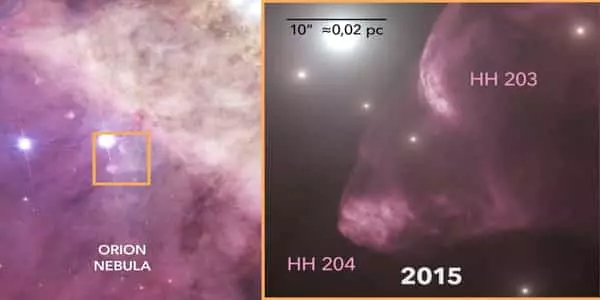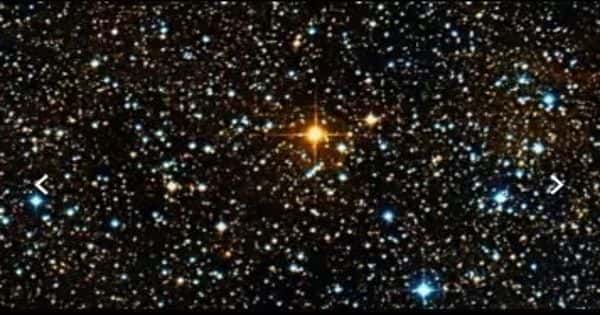The physical and chemical effects of a protostellar jet impact in the interior of the Orion Nebula have been discovered by researchers. The observations show evidence of shock front compression and heating, as well as dust grain destruction, resulting in a dramatic increase in the gas phase abundance of iron, nickel, and other heavy element atoms in the Orion Nebula.
An international team led by researchers from the Instituto de Astrofisica de Canarias (IAC) has discovered the physical and chemical effects of a protostellar jet impact in the interior of the Orion Nebula in unprecedented detail. The research was conducted using observations from the Very Large Telescope (VLT) and images from the Hubble Space Telescope collected over a 20-year period (HST). The observations show evidence of shock front compression and heating, as well as dust grain destruction, resulting in a dramatic increase in the gas phase abundance of iron, nickel, and other heavy element atoms in the Orion Nebula. The results were recently published in The Astrophysical Journal.
The Orion Nebula, one of the most well-known and bright objects in the night sky, is the closest region of massive star formation to Earth, with a complex and extensive gas structure. Some of the newborn stars within it emit high-speed gas jets that, when they collide with their surroundings, produce shock fronts that compress and heat the nebular gas. These bow-shaped impact zones are known as Herbig-Haro objects, after their discoverers, US astronomer George Herbig and Mexican astronomer Guillermo Haro.
Researchers’ observations show evidence of compression and heating produced by the shock front, and the destruction of dust grains, which cause a dramatic increase in the gas phase abundance of the atoms of iron, nickel, and other heavy elements in the Orion Nebula.
These objects have previously been observed in many dark nebulae, where the cold gas is neutral and the heat generated by the shock serves as its primary source of energy. The jets of gas in the Orion Nebula, on the other hand, are immersed in a large radiation field produced by the most massive stars in the Trapezium of Orion, which is located in the nebula’s center. The gas within the shock front, as well as the gas compressed after it has passed through, is warmed and ionized as a result of this radiation, allowing us to precisely measure the physical conditions and chemical composition of the jet.
The research, led by José Eduardo Méndez Delgado, a doctoral student at the IAC and the University of La Laguna (ULL), has uncovered the complex relationships between the ionic abundances of the gas and its physical conditions in HH204, one of the most prominent Herbig-Haro objects in the Orion Nebula.

“Our findings show that in the shock front of HH204, the gas abundances of heavy elements such as iron and nickel are increased by up to 350% compared to values typically found in the Orion Nebula, allowing us to more accurately determine the proportion of other chemical elements, which contributes to a better understanding of the chemical evolution in the solar neighborhood,” the researchers explain.
“In addition to the heavy element enrichment in the gas phase, we have observed a heated post-shock zone that comprises a very small fraction of the gas and allows us to understand the different layers of the structure of the Herbig-Haro object generated by the impact of the shock front,” says César Esteban, an IAC researcher and co-author of the paper.
“The origin of HH204 appears to be associated with one of the most brilliant and star formation rich zones of the Orion Nebula, the regions called Orion South, although there appear to be many interactions of gas which appear to feed it from several directions,” adds William Henney, a researcher at the Institute of Radioastronomy and Astrophysics at the National Autonomous University of Mexico and a co-author on the paper.
“We have shown that HH204 is propagating at an angle of 32o with the plane of the sky, which allows us to observe the compression of the gas transversely as we approach the shock front,” says Karla Arellano Córdova, a researcher at the University of Texas at Austin and co-author of the article.
“We’ve seen that the impact of these objects can be significant when it comes to determining the local physical conditions in ionized nebulae. In fact, if we do not account for these effects, we may make incorrect determinations of the chemical composition of ionized nebulae, which are critical techniques for understanding the chemical evolution of the Universe “Jorge Garca Rojas, an IAC researcher and co-author of the article, puts it succinctly.
















